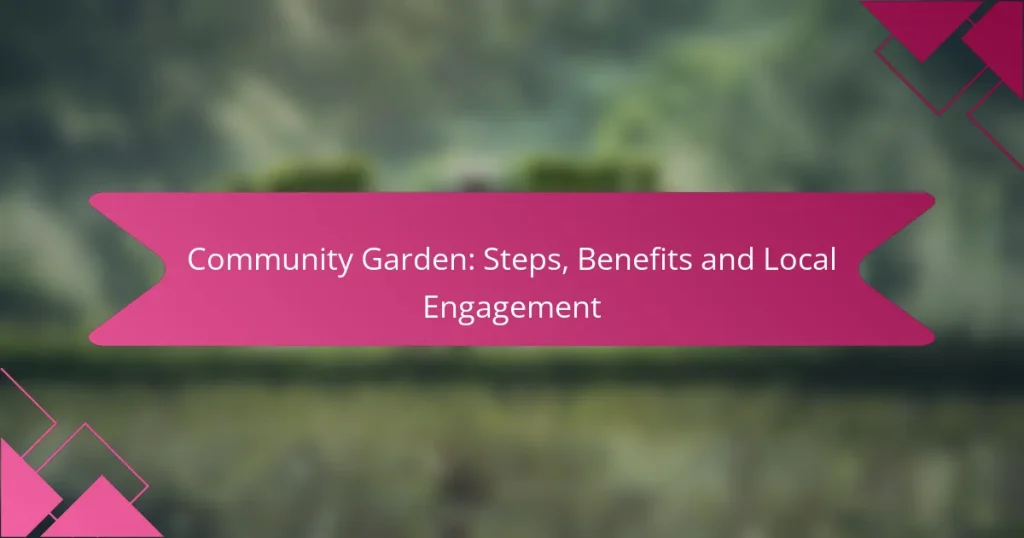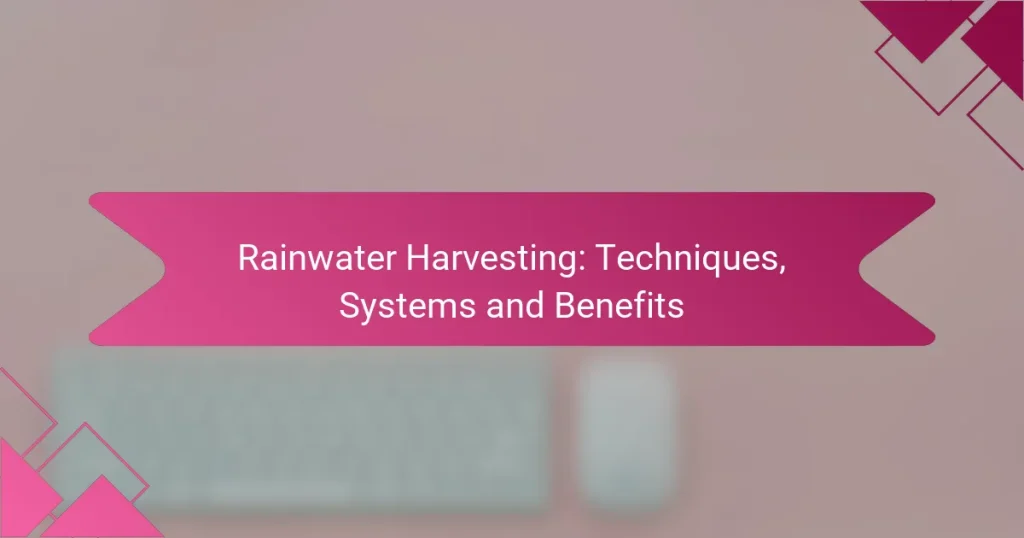Sustainable gardening practices are essential for minimizing environmental impact and fostering a healthy ecosystem. By incorporating techniques such as organic gardening, permaculture, and water conservation, gardeners can promote biodiversity and soil health. Embracing these methods not only benefits the environment but also yields nutritious produce for a healthier lifestyle.
Rainwater Harvesting: Techniques, Systems and Benefits
Soil Health: Improvement Techniques, Benefits and Sustainability
What Are the Best Sustainable Gardening Practices in the US?
The best sustainable gardening practices in the US focus on minimizing environmental impact while promoting biodiversity and soil health. These methods include organic gardening, permaculture techniques, native plant landscaping, companion planting, and water conservation methods.
Organic gardening
Organic gardening emphasizes the use of natural processes and materials to grow plants without synthetic fertilizers or pesticides. This practice improves soil health and encourages beneficial insects and microorganisms. To start, use compost, crop rotation, and organic mulch to enrich the soil and suppress weeds.
Be mindful of local organic certification standards if you plan to sell your produce. In the US, the USDA Organic label requires adherence to specific guidelines regarding inputs and practices.
Permaculture techniques
Permaculture is a design philosophy that creates sustainable and self-sufficient agricultural systems by mimicking natural ecosystems. Key principles include observing local conditions, maximizing biodiversity, and integrating plants and animals to create a balanced environment. For example, planting fruit trees alongside nitrogen-fixing plants can enhance soil fertility.
Consider starting with a small permaculture garden by incorporating elements like swales for water management and companion planting to increase productivity and resilience.
Native plant landscaping
Native plant landscaping involves using plants that are indigenous to your region, which supports local wildlife and requires less water and maintenance. These plants are adapted to the local climate and soil conditions, making them more resilient to pests and diseases. For instance, using native wildflowers can attract pollinators and other beneficial insects.
Research local native plant nurseries or extension services to find suitable species for your area. This practice not only enhances biodiversity but also reduces the need for chemical inputs.
Companion planting
Companion planting is the practice of growing different plants together for mutual benefits, such as pest control, improved growth, and enhanced flavor. For example, planting basil near tomatoes can improve tomato flavor and deter pests. This technique can maximize space and yield in smaller gardens.
When planning companion plants, consider their growth habits and nutrient needs to ensure compatibility. Avoid planting species that compete for the same resources, as this can lead to reduced yields.
Water conservation methods
Water conservation methods are essential for sustainable gardening, especially in areas prone to drought. Techniques like drip irrigation, rainwater harvesting, and mulching can significantly reduce water usage. Drip irrigation delivers water directly to the plant roots, minimizing evaporation and runoff.
Implementing a rain barrel system can also help collect and store rainwater for irrigation. Aim to use drought-resistant plants and group them according to their water needs to optimize your garden’s water efficiency.
How Can I Start a Sustainable Garden?
Starting a sustainable garden involves selecting the right location, preparing the soil, and choosing seeds that promote ecological balance. Focus on practices that conserve resources, enhance biodiversity, and minimize chemical inputs.
Choosing the right location
To establish a sustainable garden, begin by selecting a location that receives adequate sunlight, typically six to eight hours daily. Ensure the area has good drainage and is sheltered from strong winds, which can damage plants.
Consider proximity to water sources for irrigation. If possible, choose a spot that allows for rainwater collection, reducing reliance on municipal water systems.
Soil preparation techniques
Healthy soil is the foundation of a sustainable garden. Start by testing your soil’s pH and nutrient levels to understand what amendments are needed. Organic matter, such as compost or well-rotted manure, can enhance soil fertility and structure.
Avoid chemical fertilizers; instead, practice crop rotation and cover cropping to naturally replenish nutrients. Tilling should be minimized to protect soil organisms and prevent erosion.
Seed selection for sustainability
Choose seeds that are native or well-adapted to your local climate, as they typically require less water and are more resistant to pests. Heirloom varieties can also be a great option, as they promote biodiversity and can be saved for future planting.
Look for seeds that are certified organic or non-GMO to ensure they align with sustainable practices. Consider starting with a mix of annuals and perennials to create a resilient garden ecosystem.
What Are the Benefits of Sustainable Gardening?
Sustainable gardening offers numerous advantages, including environmental protection, enhanced biodiversity, and improved health through organic produce. By adopting sustainable practices, gardeners can contribute to a healthier ecosystem while enjoying the fruits of their labor.
Environmental impact reduction
Sustainable gardening significantly reduces environmental impact by minimizing chemical use and promoting natural processes. Techniques such as composting, rainwater harvesting, and organic pest control help conserve resources and reduce pollution.
For instance, using compost instead of synthetic fertilizers not only enriches the soil but also decreases the carbon footprint associated with manufacturing and transporting chemical fertilizers. Implementing these practices can lead to a more sustainable garden that supports the environment.
Improved biodiversity
By creating diverse ecosystems, sustainable gardening enhances local biodiversity. Planting a variety of native species attracts beneficial insects, birds, and other wildlife, which can help control pests naturally and pollinate plants.
Incorporating companion planting, where different plants are grown together for mutual benefit, can further boost biodiversity. This practice encourages a balanced ecosystem, making gardens more resilient to diseases and pests.
Health benefits of organic produce
Growing organic produce through sustainable gardening practices offers significant health benefits. Organic fruits and vegetables are free from synthetic pesticides and fertilizers, reducing the risk of chemical exposure for consumers.
Additionally, studies suggest that organic produce may contain higher levels of certain nutrients compared to conventionally grown options. By cultivating your own organic garden, you can ensure fresh, healthy food while supporting sustainable agriculture practices.
What Tools Are Essential for Sustainable Gardening?
Essential tools for sustainable gardening include hand tools, composting systems, and rainwater harvesting systems. These tools help promote eco-friendly practices while enhancing the efficiency and productivity of your garden.
Hand tools for organic gardening
Hand tools are crucial for organic gardening as they allow for precise control and minimal soil disturbance. Essential tools include trowels, pruners, and hoes, which help with planting, maintaining, and harvesting crops.
When selecting hand tools, consider ergonomics and durability. Opt for tools made from sustainable materials, such as bamboo or recycled metals, to reduce environmental impact. Regular maintenance, like cleaning and sharpening, will extend the life of your tools.
Composting systems
Composting systems are vital for recycling organic waste and enriching soil health. A simple compost bin can turn kitchen scraps and yard waste into nutrient-rich compost, which can be used to improve soil structure and fertility.
When setting up a composting system, balance green materials (like vegetable scraps) with brown materials (like dry leaves) to achieve optimal decomposition. Aim for a compost pile that is at least one cubic meter to maintain heat and speed up the process. Regularly turning the pile will aerate it and enhance decomposition.
Rainwater harvesting systems
Rainwater harvesting systems collect and store rainwater for garden use, reducing reliance on municipal water supplies. A basic system can include rain barrels connected to downspouts, providing a sustainable water source for irrigation.
When installing a rainwater harvesting system, ensure that barrels are covered to prevent mosquito breeding. Aim for a storage capacity that meets your garden’s needs, typically ranging from 200 to 1,000 liters. Regular maintenance, such as cleaning gutters and checking for leaks, will keep the system functioning effectively.
How Do I Maintain a Sustainable Garden?
Maintaining a sustainable garden involves practices that promote ecological balance, conserve resources, and enhance biodiversity. Key strategies include using organic methods, conserving water, and selecting native plants that thrive in your local environment.
Use Organic Gardening Techniques
Organic gardening focuses on natural methods to grow plants without synthetic fertilizers or pesticides. Techniques such as crop rotation, composting, and natural pest control can improve soil health and reduce environmental impact. For instance, introducing beneficial insects like ladybugs can help manage pests without chemicals.
Implement Water Conservation Strategies
Water conservation is crucial for sustainable gardening, especially in areas prone to drought. Techniques like drip irrigation, rainwater harvesting, and mulching can significantly reduce water usage. Aim to collect rainwater in barrels and use it to irrigate your garden, which can cut down on municipal water costs.
Select Native Plants
Choosing native plants for your garden supports local ecosystems and requires less maintenance. Native species are adapted to the local climate and soil, making them more resilient to pests and diseases. Additionally, they often need less water and fertilizer, contributing to a more sustainable garden.
Practice Soil Health Management
Healthy soil is the foundation of a sustainable garden. Practices such as adding organic matter, avoiding chemical fertilizers, and minimizing soil disturbance can enhance soil structure and fertility. Regularly testing your soil can help you understand its nutrient needs and adjust your practices accordingly.
Encourage Biodiversity
Promoting biodiversity in your garden can create a balanced ecosystem. Planting a variety of species, including flowers, vegetables, and herbs, can attract beneficial insects and pollinators. Consider creating habitats like birdhouses or insect hotels to support wildlife and enhance your garden’s resilience.


